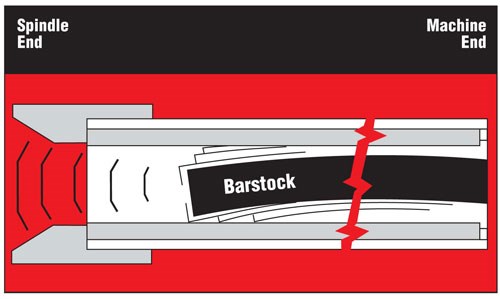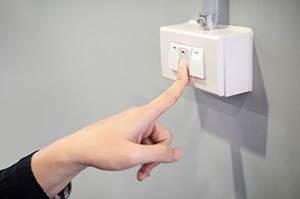Line Your Spindles, Line Your Pockets
Urethane spindle liners present a viable option to steel to fill the gap between spindle ID and bar OD. They protect both the spindle and bar stock and increase machine performance.
Spindle ID, relative to the diameter of the barstock being fed through it, can have a significant effect on the performance of a turning operation. Obviously, the spindle ID must be large enough to fit the barstock, but if it is too large, excessive whipping and vibration of the bar can occur, resulting in potential damage to the spindle, marring of the barstock itself, and overall poorer performance.
To combat the negative effects that can occur when barstock diameter is considerably smaller than a spindle, spindle liners can be used to fill the gap. These liners effectively reduce the spindle ID to between 0.030" and 0.060" greater than the diameter of the bar being machined. The closer fit keeps the barstock on center in the spindle and allows faster machining speeds and closer machine tolerances. In automated systems, the spindle liner also helps align the bar with the collet opening as it is fed into the lathe, preventing it from jamming against the inside of the collet.
Spindle liners are available in a variety of materials including, most commonly, steel and urethane, as well as composite substances. Even with steel liners, which can be made with extensions to increase lathe spindle capacity, the additional weight of the liners stays easily within the capacity of the lathe without affecting spindle bearing or drive wear. The hardness of the steel helps minimize the accumulation of metal chips that can affect the finish of the part.
Through a series of product developments, one manufacturer has capitalized on the need for one-piece spindle liners constructed with non-metal material and has sought to provide a product with additional advantages beyond those of steel liners. Trusty-Cook Inc. (Indianapolis, Indiana) offers a line of urethane spindle liners that, according to Jeff Nawrot, vice president of business development, are designed to reduce machine vibration while providing more durability at a reduced cost.
The company’s original product was a urethane deadblow hammer. About 35 years ago, while selling the hammers to the major automobile manufacturing plants, Jon Trusty, Sr., and Bill Cook, the company founders, noticed the exceptional noise generated by the banks of multi-spindle screw machines in the plants. Along with one of their customers, they developed the idea to use the same urethane material used to produce the hammers to make a product to line the stock feeder tubes. This product became the company’s Hush Tube, a product that has required very little change through the years, yet continues to help plants meet OSHA noise standards by absorbing and dampening the sound level normally transmitted throughout the stock feeder tube.
Using a similar concept as that encompassing the Hush Tube, Trusty-Cook’s patented urethane spindle liners were the next product to evolve at the company. While steel liners still may be more suitable for certain applications, these urethane liners offer an alternative for high-production shops looking to squeeze out more productivity. Mr. Nawrot explains, “Since IMTS 2000, we began capturing market share based on price, as people started requesting our liners from the machine tool manufacturers and their dealer networks. In some cases, users have stated that, not only do their machines run faster and quieter with the urethane spindle liners, but the urethane has also held up better than the steel over time because it does not corrode or rust, and it can be dropped without ruining the liner or having to rebalance it.”
As the company’s liners have become more established in the marketplace (Mr. Nawrot estimates 30 to 50 percent of the market share), the capability of providing shaped ID has become a big selling point. “We’re now trying to seek out some other markets and marketing new ways of feeding stock,” says Mr. Nawrot, “which is where the shaped ID comes in. With hex shapes, squares, rectangular work and extruded off-center jobs, we can help the customer base re-examine and sometimes reinvent ways in which they are machining.”
While steel liners are available for square and hex shapes, the pins placed in intermittent locations on either side to hold the liner’s shape can sometimes create issues. If both sides of the liner are not perfectly aligned and a bar that is bent or a little off center is fed in, the bar can hit a pin and dislocate it and could cause a loss of orientation. If this occurs, the chuck or collet will not have accurate gripping and the machine will alarm out. The urethane liners have the shapes molded (with clearance for the barstock to go through), so feeding is as smooth with irregular shapes as with round stock.
Avoiding machine stoppage with the shaped ID all the way through the urethane liner is most significant with lights-out operations. To further ensure the process, once the liner is installed, oriented properly and fixed to the machine so orientation is maintained, a deep lead-in chamfer can be added as well so that every time a bar is fed, it is a smooth transition from the bar feeder to the liner to the collet or chuck.
Expressing his confidence in the product, Mr. Nawrot explains, “If sized correctly and used in the right applications, urethane spindle liners can provide maximum bar control and orientation relative to the chuck or collet. The one-piece urethane construction provides improved vibration reduction properties resulting in better tolerances and the ability to run at rpm as much as 20 to 30 percent higher.
“This is an exciting time in the evolution of our product line,” he concludes. “With the availability of virtually any shape ID molded into the spindle liners, customers can now gain a production edge by using automatic bar feeding and CNC lathe technology for jobs that once were not possible or had to be completed in multiple-machine cell operations.”
Related Content
4 Bright Ideas for Effective Lights-Out Machining
Adopting lights-out machining involves considerations when a machine shop decides to move forward with the process. Here are some tips to a successful implementation.
Read MoreUnattended Production Takes More Than the Most Capable CNC Machine
Process planning and reliable peripherals are key to successful lights-out manufacturing.
Read MoreInside the Premium Machine Shop Making Fasteners
AMPG can’t help but take risks — its management doesn’t know how to run machines. But these risks have enabled it to become a runaway success in its market.
Read MoreChuck Jaws Achieve 77% Weight Reduction Through 3D Printing
Alpha Precision Group (APG) has developed an innovative workholding design for faster spindle speeds through sinter-based additive manufacturing.
Read MoreRead Next
Accurate Barstock Alignment Provides Faster Speeds
Recent developments in sliding-headstock turning machines allow for faster feed rates and higher spindle speeds—both aimed at increasing throughput to improve productivity. Sometimes, though, these machines cannot reach their full potential because of other equipment that runs in conjunction with it.
Read MoreOne Guide Channel, No Spindle Liners
It’s only 5 years old, but bar feed manufacturer Top Automazioni is growing fast. On a recent visit to the company headquarters in Italy, I found out first hand how technology has developed faster change-over of bar feeders and how it is fueling demand.
Read MoreSeeing Automated Workpiece Measurement in Real Time
User-friendly inspection software for CNC machining centers was shown at IMTS 2024 monitoring measurements between and after machining while performing SPC based on recorded measurement values.
Read More

























